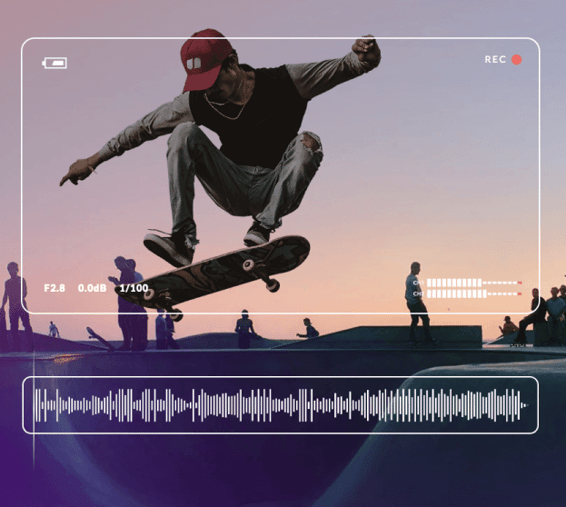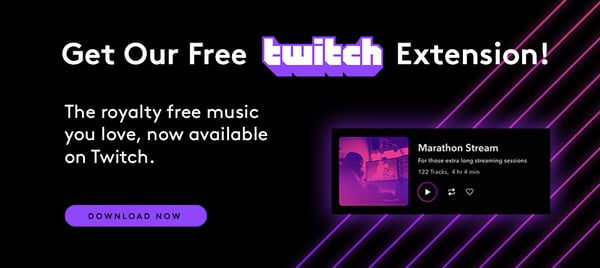Welcome to Outstanding
Twitch Music






Listen to Our Best Twitch Music
Setting the right mood is vital when you're live streaming. And quality music makes all the difference. Good news: we've got a library full of it. Check out this curated playlist with our best music for Twitch.
Looking for something different?
We got you. From classical to hip hop to indie, our audio library contains thousands of outstanding tracks. Use one of our 13 filters or check out other curated playlists to find what you need in minutes.
BROWSE THE FULL CATALOG
Dead Simple Licensing
Never worry about licensing again. With Soundstripe, your membership covers the cost for every song license. Just find the right track, download the file, and get a custom license. That’s it. No channel or media-specific fees, no recurring royalties, ever. Here’s more good news: you have unlimited licenses. Go ahead, download as many songs as you want.
The Streamer’s Guide to Twitch Music
Everybody wants to make it big as a streamer. And by all indications, there’s never been a better time to try.
Gaming has long been a sleeping cultural giant, growing in the shadow of the music and movie industries.
Numerous reports show the video game industry pulls in more money than the film industry. The rise of Twitch and livestreaming threw fuel on a fire that had already been burning for decades.
And if we’re talking about streaming, there’s really only one place to go: Twitch.
Sure, Microsoft has Mixer, but Twitch still owns around 76% of the streaming market in the U.S. and Europe. If you want to build a following, go where the people are.
Building a loyal following is about more than just being elite at video games — although that certainly helps. You have to become an on-air personality, and build yourself a brand.
Music plays a huge part in that, because it sets the tone for your stream. And if you maintain a certain style of background music, then it will set the tone for your entire channel.
Unfortunately, there’s a lot more to it than just grabbing random songs you like and playing them when you go live. You need to be deliberate about what music you choose, and how you go about playing music on Twitch.
To help you out, we made this guide. Here’s a quick look at what you’ll learn:
- Choosing Music for Streaming
- Why Music Licensing Matters
- Royalty Free Music for Twitch
I. Choosing Music for Streaming
Every stream focuses on a triumvirate of sound: the gameplay, the narration, and the background music. The most important are the first two: gameplay and narration.
No one wants to watch a game without the sound effects, because that’s what pulls people into the game’s world. That’s what makes everything feel a little more real.
Narration is whatever the streamer is saying while they play. There could be thousands of words written on which type of narration is most effective and why, so we’ll leave it at this: narration is important. It’s what keeps people entertained, and it’s what makes you different.
Make sure your narration is on point.
Last but not least, we have the background music. The background music helps you create an atmosphere. Science has shown us that music has a direct line to people’s emotions. That’s why we so often listen to music to change our mood.
So choosing music for your stream is important, because it makes a difference. If you’re playing a slow, exploration-style game like Abzu you’re not going to start blasting some dirty club bangers.
That wouldn’t match the mood of the game — not necessarily because of the genre, but because of the tempo. The audience will find it jarring.
Conversely, if you’re parachuting into a Warzone match, some trap music is probably a fantastic idea. It’ll get everyone primed for the impending action.
Even though genre is an important factor for your music, the pace of the music and how well it matches the speed of your game should be your highest priorities.
Popular Genres of Twitch Music
The genre of the music you play is all about your personal style and taste. Don’t worry so much about whether or not a genre will match the tempo of your game. You can find slow, medium, and fast songs in just about any genre.
For the sake of reducing your search, here are a few popular genres for Twitch streaming:
Electronic
Perhaps the most versatile of popular genres for streaming, electronic music can match nearly any mood or tempo.
Obviously, there’s the upbeat, sometimes frantic, options that would probably suit a stream filled with intense FPS action. On the opposite end of the spectrum lies the chiller side of electronica, which suits anything from a platformer to a slower RPG grind.
Indie-Pop
If you're streaming a game on the lighter side, nothing beats some sunbaked indie-pop. Frequent harmonies and dreamy guitars are regulars in this genre, and they’ll put your entire audience in a calm, satisfied mood. What could go wrong when the acoustic guitars hit with the chorus?
Thousands of streamers are no doubt playing this genre behind Animal Crossing as you read this.
Hip-Hop
Hip-hop has always been a versatile genre, but it’s become even more expansive in the last decade. This is fantastic news for streamers, because it gives you the opportunity to pick and choose the perfect beat for whatever you’re playing. Doing some exploring? Try something more meditative. About to fly into battle? Add some more bars and start doing work.
These are just a few recommendations based on what we’ve seen from our Twitch playlists at Soundstripe. Technically, you can use any type of genre while you stream. Choosing something unexpected might even set you apart and pique viewers’ interest.
Maybe royalty free cinematic music and Call of Duty were always meant to be.
II. Why Music Licensing Matters
To be frank: music licensing matters because Twitch says it does.
Twitch’s rules state there are only three types of music you are allowed to play while streaming:
- Original music that you own.
- Copyrighted music that you have already licensed.
- Music outside of the first two parameters is allowed only if you’re performing on Twitch Sings.
Pretty straightforward. Also pretty limiting.
The bigger question is “Why does Twitch care about music licensing at all?” Because using music without permission is illegal. If Twitch allows streamers to use copyrighted music without consequence, it’s going to have to answer to a lot of powerful record labels.
Basically, Twitch will get sued for a lot of money, and they don’t want that. The music industry has a long history of pursuing organizations and people who use copyrighted music without permission.
In 2019, the National Music Publishers’ Association (NMPA) sued exercise bike makers Peloton for $300 million. NMPA claimed Peloton used over 2,400 unlicensed songs in the workout classes that come preloaded on the exercise bikes.
Peloton was preparing to go public on the New York Stock Exchange, and the lawsuit royally screwed their plans. They eventually settled for a far reduced sum, but the damage was done.
A Tyranny of Algorithms
Twitch doesn’t want something similar to happen to them, so they use algorithms that tirelessly patrol their entire platform looking for songs that match a database compiled by organizations like NMPA.
If Twitch’s robot sentries sniff out an unlicensed use of a song in their database, they’ll report it and slap you with a ban. Most bans are temporary, but Twitch will only forgive you three times. Earn a third strike, and you’re gone for good.
YouTube also employs a seek-and-destroy operation with its Content ID algorithm. Consequently, there have been lawsuits like Peloton’s filed against content creators for using unlicensed music. But in most cases, people are getting temporarily banned.
The streaming community has dubbed these “DMCA strikes” because YouTube and Twitch rely on the Digital Millennium Copyright Act to justify the rules they’ve put in place.
Here’s the problem: the system doesn’t always work.
Despite the tremendous mathematical engines powering these algorithms, they can make mistakes. There have been multiple accounts of streamers getting temporary bans that were eventually overturned.
It would be remiss to say these kinds of instances are rampant, but they can and do happen. Streamers complained that Twitch flagged songs from its own music library as violations of its music policy. So, not great.
The best thing you can do to protect yourself from DMCA strikes — or combat them if you find yourself a target — is to have a license for the music you want to use.
The True Necessity of Music Licensing
If complex algorithms produced by Twitch and YouTube consistently misidentify unlicensed music, why do they still exist?
The answer is simple: using unlicensed music is theft.
Musicians and artists rely on revenue from royalties derived from licensing agreements. When someone uses an artist’s song without their permission, they are in fact stealing that artist’s intellectual property.
Of course, that logic comes with a host of caveats. Record labels and publishers exert the most control over which songs get licensed — not songwriters and musicians. This same cadre of copyright holders also makes licensing from big labels outlandishly expensive.
From a philosophical point of view, there’s also room for debate about the purpose of art writ large for society. The European view is that art should be for the people. It should be developed for the enjoyment, even enlightenment, of the masses.
The American approach is a bit different. Art is often classified as the property of a person or group. And that group has certain rights as they relate to their art. Regardless of whatever side you fall on, the law of the land is that music must be licensed in order for you to use it.
Even with those caveats in mind, the enduring truth is that music licensing does benefit people who make music. Artists and songwriters deserve a system that enables them to support themselves through their work.
III. Royalty Free Music for Twitch
Thankfully for streamers — and basically all modern content creators — music licensing is undergoing something of a revolution.
If you want to license popular songs from labels, you have to connect with multiple stakeholders, beg each one to agree to let you license the song, and then sign a complex licensing agreement that includes all types of usage rights limitations.
Oh, and the price will also be exorbitant.
This is where that revolution comes in. Companies like Soundstripe have helped popularize “royalty free music.” This type of music is made for simple licensing and use in digital content, like livestreams.
The overarching goal is to finally create an arrangement that benefits both musicians and digital content creators. Here’s how it works:
Typically when you license a song, you have to agree to pay royalties to the artist and label. Companies like Soundstripe work directly with musicians to obtain copies of the master rights and publishing rights of a song. It’s complicated, but that means we can set the rules about usage rights and licensing agreements.
And we’ve made it dead simple. Just sign up for a membership, find songs that you like, tell us about your project, and you’re done. You can use that song in as many streams as you want for as long as you want.
It’s important to stress just how far the industry has come for streamers. Even when music licensing companies started making waves in the market, they weren’t so permissive with their usage rights, i.e., the terms under which you could use music.
Some companies would also let you use a song at one price until you hit a certain number of views, which would then trigger a clause that says you owe more money.
Insane right? We think so too. That’s why we offer unlimited licensing which allows you to use each song you download in perpetuity — we’re talking forever.
And the musicians? A portion of every subscription goes directly to the musicians who write and record the music in our library. That’s why the music is “royalty free,” your subscription supports the people who make the music, not some arcane set of rules written into a contract.
Even better: we care a lot about quality. We were founded by three professional musicians, so we’re obsessed with supplying creators with label-quality songs.
If you’re in need of some quality tunes for your next stream, browse our library or check out the playlist we made above. We bet you find something (and probably several somethings) you love.
We know streaming isn’t going anywhere; it’s only growing. Music is a cornerstone of human culture, so it’s here to stay too. And royalty free music is the bridge between the worlds.


Have questions? Give us a call
855.224.0847
Soundstripe - Unlimited Music for Video
© 2017-2020 A Product of Soundstripe, Inc
Nashville TN




